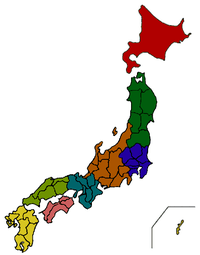Morioka Castle
| Morioka Castle 盛岡城 | |
|---|---|
| Morioka, Iwate, Japan | |
|
Morioka Castle | |
| Coordinates | Coordinates: 39°41′59.81″N 141°09′0.04″E / 39.6999472°N 141.1500111°E |
| Type | hirayama-style Japanese castle |
| Site information | |
| Owner | city of Morioka |
| Condition | National Historic Sites of Japan |
| Site history | |
| Built | 1598-1633 |
| Built by | Nanbu clan |
| In use | 1633-1871 |
Morioka Castle (盛岡城 Morioka-jō) is a hirayama-style Japanese castle constructed in 1611. It was the seat of the Nanbu clan, a 100,000 koku tozama daimyō clan who ruled over Morioka Domain, Mutsu Province, in what is now central Morioka, Iwate Prefecture, Japan. It was also referred to as Kozukata Castle (不来方城 Kozukata-jō), but strictly speaking this name pertains to the predecessor of Morioka Castle on the same site.
Background
The confluence of the Kitakami River and the Nakatsu River was of strategic importance in control of river traffic in central Oshu, and a castle was built on this located during the late Heian period by the Kiyohara clan.
History
During the late Sengoku period, former Nanbu Nobunao lord of Fukuoka Castle in Kunohe was awarded holdings in Mutsu Province exceeding 100,000 koku, including the site of old Kozukata Castle and received permission to build a new castle from Toyotomi Hideyoshi. These holdings were confirmed after the Battle of Sekigahara by Tokugawa Ieyasu. The actual construction work on the new castle was supervised by his Nanbu Nobunao’s son, Nanbu Toshinao, who later became the 1st daimyō of Morioka Domain, but the castle was not completed until 1633, during the reign of Nanbu Shigenao, the 2nd daimyo.
However, its three-story donjon burned down only one year later, and was never rebuilt. Morioka Castle remained the seat of the Nanbu rulers of Morioka Domain until the end of the Tokugawa shogunate. In 1906, the site was opened to the public as Iwate Park, with gardens laid out by modern park designer Yasuhei Nagaoka, and are a popular spot for viewing the sakura blossoms in spring. The caste site was donated by the Nanbu clan to the city of Morioka in 1934.
In 1937, the grounds were designated as a National Historic Site.[1] In 2006, Morioka Castle was listed as one of the 100 Fine Castles of Japan by the Japan Castle Foundation.
Structures and gardens
Morioka Castle has a continuous enclosure positioned on a granite hill in the central part of the modern city of Morioka. The Kitakami River on the west and the Nakatsu River on the southeast form natural outer moats. A secondary enclosure is positioned at the northern part of the inner citadel, and a red-painted bridge spans a moat that divides the two enclosures. There is a tertiary enclosure positioned at the northern end; a Koshi no kuruwa (腰曲輪), a Awaji maru (淡路丸) and a Sakakiyama kuruwa (榊山曲輪) enclose the inner citadel.
The castle has a stone wall constructed in white granite, which stands out among the castles of the Tōhoku region, most of which having earthen walls. All of the structures of the castle were dismantled during the early Meiji period, with the exception of a storehouse with thick mortar walls, reconstructed in the interior part of the castle, and a gate which is now relocated to a Zen temple within the city.
The surrounding Iwate Park (岩手公園 Iwate Kōen) (now known as Morioka Castle Ruins Park (盛岡城跡公園 Morioka-jō ato kōen)) contains a monument inscribed with a poem of Kenji Miyazawa, and also a monument in memory of Takuboku Ishikawa inscribed with one of his poems:
| “ | 不来方のお城の草に寝ころびて空に吸はれし十五の心
Kozukata no oshiro no kusa ni nekorobite sora ni suwareshi jū-go no kokoro (English: I laid down on the grass of the Kozukata Castle, absorbed by the sky; my heart of fifteen) |
” |
Bibliography
- Schmorleitz, Morton S. (1974). Castles in Japan. Tokyo: Charles E. Tuttle Co. pp. 144–145. ISBN 0-8048-1102-4.
- Motoo, Hinago (1986). Japanese Castles. Tokyo: Kodansha. p. 200 pages. ISBN 0-87011-766-1.
- Mitchelhill, Jennifer (2004). Castles of the Samurai: Power and Beauty. Tokyo: Kodansha. p. 112 pages. ISBN 4-7700-2954-3.
- Turnbull, Stephen (2003). Japanese Castles 1540-1640. Osprey Publishing. p. 64 pages. ISBN 1-84176-429-9.
External links
![]() Media related to Morioka Castle at Wikimedia Commons
Media related to Morioka Castle at Wikimedia Commons
Notes
- ↑ Agency for Cultural Affairs (Japanese)
